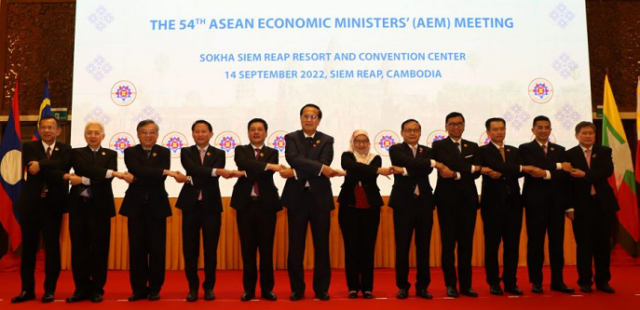
- ASEAN ministers say RCEP free trade pact could help the regional group’s post-COVID-19 recovery efforts, as they note the ASEAN economy grew 3.4% in 2021, driven by a strong rebound in consumption, investment and trade
- RCEP ministers who met on the sidelines of the 54th ASEAN Economic Ministers’ Meeting in Siem Reap urge all countries in the region to ratify the agreement
- The ministers agreed RCEP could help create a more resilient supply chain and members need to push greater use of the pact to deepen economic integration
- Only the Philippines and Myanmar still have to ratify the RCEP agreement
The Regional Comprehensive Economic Partnership, or RCEP’s, role in ASEAN post-pandemic recovery efforts has been highlighted by the Association of Southeast Asian Nations in a joint statement on September 18.
The statement was issued after the inaugural RCEP Ministers’ Meeting on the sidelines of the 54th ASEAN Economic Ministers’ Meeting in Cambodia’s Siem Reap province.
The ministers reiterated ASEAN’s unwavering commitment to regional economic integration amid continued pandemic-related challenges and rising geopolitical tensions.
“The meeting was pleased to note that the ASEAN economy expanded by 3.4% in 2021 with growth driven by a strong rebound in consumption, investment and trade, supported by the successful rollout of vaccination programs that enabled economies in the region to reopen domestically,” the statement said.
The ministers noted that as of mid-August 2022, the full dose vaccination rate in ASEAN had reached 69%, while 30.5% of the population had received booster shots.
They expressed optimism that the growth momentum would continue in 2022 and 2023, with growth forecast at 5.0% and 5.2%, respectively.
Separately, the ASEAN ministers welcomed the RCEP agreement that took effect on January 1, 2022, expressing hope for its ratification by all signatory states. The pact was signed by ASEAN and its trade partners on November 15, 2020 after years of negotiations.
“The meeting shared the view that the RCEP could contribute to the region’s post-pandemic recovery efforts and to creating a more resilient supply chain. In this regard, the meeting highlighted the need to promote greater utilization of the RCEP agreement to deepen regional economic integration,” the ministers said.
The mega-regional trade pact comprises 15 Asia-Pacific countries including 10 ASEAN member states – Brunei, Cambodia, Indonesia, Laos, Malaysia, Myanmar, the Philippines, Singapore, Thailand and Vietnam – and their five trading partners, namely China, Japan, South Korea, Australia and New Zealand.
The Philippines and Myanmar are the only countries that have yet to ratify RCEP agreement after Indonesia ratified the trade deal in early September.
On August 14, the National Economic and Development Authority pushed for the immediate ratification of the RCEP agreement, saying the PPhilippines needs to send a clear signal that it is open to investments that will generate more jobs.
Socioeconomic Planning Secretary Arsenio Balisacan told media that NEDA supports the immediate ratification of the RCEP, saying the Philippines should not be left behind as other ASEAN countries are now benefitting from RCEP.
“If we say we are open to trade, open to business, open to investment, let’s adopt those parts of the governance framework for trade and investment. We cannot be left behind,” he said. The Senate, however, has dragged its feet on the RCEP ratification.
A World Bank report this year acknowledged the economic benefits from RCEP, saying Cambodia, Vietnam and Malaysia are expected to gain the most from it.
The WB said the average trade weighted tariff imposed by Vietnam declines from 0.8% to 0.2% while tariffs it faces are reduced from 0.6% to 0.1% between 2000 and 2035.
In the most optimistic scenario, Vietnam has the highest gains of all RCEP member countries, with income levels to rise 4.9% relative to the baseline, higher than other countries, where the income level increases by 2.5%.
Trade also increases the most in this scenario, with exports expanding by 11.4% and imports by 9.2%. All RCEP member countries will see an increase in exports and imports, the report said, with Vietnam’s exports expanding by 11.4% and imports by 9.2%.
“The RCEP trade deal is an important instrument to boost the post-pandemic economic recovery in the region,” Cambodian Commerce Undersecretary Penn Sovicheat said after the meeting.
“For Cambodia, the RCEP has injected new momentum into our foreign trade growth, and we have seen a remarkable rise in our exports to RCEP member countries in the first half this year.”
Sovicheat said Cambodia’s total export to the RCEP member countries had increased to US$3.28 billion during the January-June 2022 period, up 10% from a year ago.








